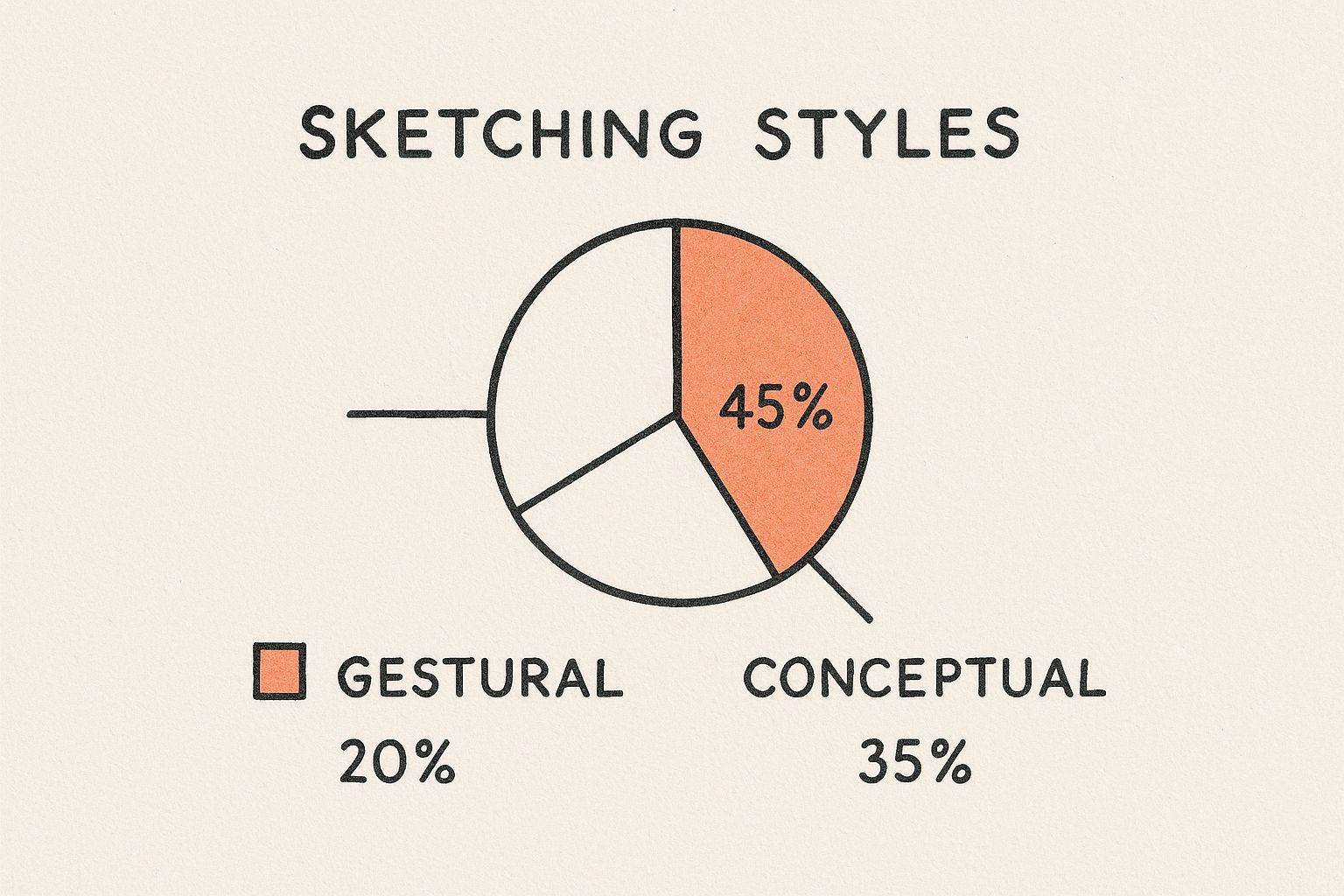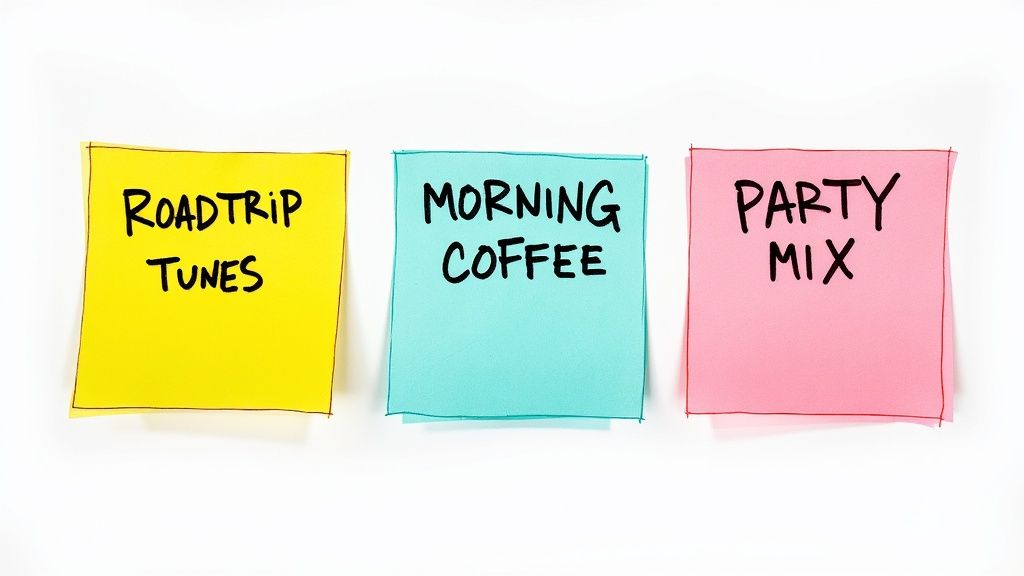How to Name Playlists for Growth and Discovery
- bekimmusic
- Oct 6
- 10 min read
Knowing how to name a playlist is really about making it discoverable. The secret sauce? It’s a mix of a specific mood, activity, or genre, blended with the exact keywords real listeners are punching into Spotify. This way, your playlist doesn't just sound great—it actually gets found.
Why Your Playlist Name Drives Everything

Let's get one thing straight: if you're a playlist curator, the name of your playlist is critical in order for it to grow. It's your single most powerful growth tool. In a world drowning in music, the right name is the only thing separating a playlist that gets discovered from one that’s lost in the digital static forever. It’s the first impression, the hook, and the main engine for your search visibility.
Think of it as the headline for your music collection. A vague or overly artistic name might feel cool, but if nobody is searching for those terms, all your hard work curating goes down the drain. The real goal is to tap directly into a listener's intent the moment they need music.
The Foundation of Discoverability
A well-crafted name builds a bridge right from your playlist to a potential fan. It needs to instantly signal the vibe, feeling, or activity it’s built for. Getting this right is absolutely critical for grabbing attention and earning that first click.
Your playlist name and its description are the most important pieces of metadata for search algorithms. They tell platforms like Spotify exactly who your playlist is for, increasing the chances it will be recommended to the right audience.
This is exactly why thinking about SEO from the jump is non-negotiable. Playlists have become a massive force in music discovery, now accounting for 31% of how listeners find new tracks. This discovery happens across three main playlist types:
Editorial Playlists: Curated by Spotify's own team (think RapCaviar).
Algorithmic Playlists: Personalized for each user (like Discover Weekly).
User-Generated Playlists: Created by listeners and curators just like you.
To have any chance of competing, your playlist has to be optimized to show up in search. And that whole journey starts with a name that understands how people actually look for music. If you really want to see how important this is, you can dig into more music streaming statistics.
Think Like a Listener to Find Your Name
If you want to craft a playlist name that actually connects, you have to stop thinking like a curator for a second and start thinking like a listener. Seriously. Forget what you think is clever. The real key to discoverability is getting inside the head of someone who needs music right now and figuring out the exact words they'd type into that Spotify search bar. You want a name that people actually type in search.
Your goal is to shift from just guessing what might sound cool to making a decision based on real behavior. People search for music based on moods, activities, genres, and specific artists. They have a problem and they're looking for a solution: music for studying, a playlist for a road trip, or songs that sound like their favorite band.
Uncovering What People Actually Search For
The best way to figure out what listeners want is to look at what they’re searching for. You can use platforms like artist.tools and its Search Suggestions feature to see what users are typing on Spotify. This gives you a massive advantage by showing you the popular keyword combinations people are using every single day.
For instance, you might learn that listeners search for "chill lofi beats" way more often than "relaxing instrumental music," even if they essentially mean the same thing. That small difference in wording can be the deciding factor in whether your playlist gets found or gets lost.
This is all about aligning with existing demand. Think of a popular search term like "Chill Vibes" as a giant magnet, pulling listeners directly to playlists that use that exact phrase.

As you can see, matching your playlist name to what people are already looking for is the most direct path to getting discovered.
Don't Forget Your Playlist Description
This same search-first mindset applies directly to your playlist description. It's not just a spot for a witty one-liner; it's another prime piece of real estate to tell Spotify's algorithm what your playlist is all about. You want to include relevant phrases and keywords people are actually typing.
Think of your description as an extension of your title. Pack it with relevant keywords, artist names, and related genres that people might search for. This helps Spotify connect your playlist to the right audience.
For example, if your playlist is called "Morning Coffee Acoustic," your description should be loaded with related terms. Something like:
Relaxing acoustic songs for a slow morning.
Featuring indie folk artists like Bon Iver and The Lumineers.
The perfect soundtrack for studying, reading, or just waking up.
By peppering in these terms, you create more pathways for listeners to find you. This strategy is a core part of building an audience, and our guide on **social media marketing for musicians** dives deeper into how you can connect with the right people. Your name and description are a one-two punch that attracts both human listeners and the algorithm.
Crafting Names That Capture a Vibe
The very best playlists don't just list songs; they sell an experience. While having searchable keywords is the foundation, the real magic happens when you craft a name that locks into a specific vibe or moment. This is how you create an emotional connection before anyone even hits play.
Think about the playlists that have blown up, like "lofi beats to study/relax to" or "kitchen disco." These names instantly paint a picture. You know the mood, the setting, and exactly how the music will make you feel. They aren't just labels—they're invitations. That's the goal.
Brainstorming Evocative Names
The trick is using language that taps into senses and cultural moments to make your playlist feel essential. Start by just riffing on words associated with the feeling you're going for. Is it for a lazy Sunday morning? Think "Warm Sunlight," "Coffee & Chill," or "Easy Mornings."
The most effective playlist names often blend a specific activity with an emotion or a genre. This combination makes them highly specific and relatable, which increases their shareability and memorability.
This trend is all over Spotify. Successful playlist titles mix keywords for mood, activity, and genre to get discovered. Iconic names like "Chill Vibes" or "RapCaviar" became cultural touchstones because they were instantly clear and appealing. Time and again, playlists with concise, creative titles outperform those with generic names in follower growth and search ranking. It just goes to show how critical a little SEO can be. You can learn more about popular playlist naming trends to see how the pros do it.
Practical Techniques for Creativity
Feeling stuck? Don't worry. Sometimes you need a little push to get the creative gears turning. This is less about data and more about feel, but the results can be just as powerful for building a loyal following.
Mind Mapping: Start with your core genre (e.g., "Indie Rock"). From there, branch out with activities ("Road Trip," "Late Night Drive"), feelings ("Nostalgic," "Uplifting"), and sensory words ("Golden Hour," "Rainy Day"). You'll be surprised what connections you find.
Use a Formula: Combine different elements like [Time of Day] + [Activity] or [Feeling] + [Genre]. This simple method can churn out great, effective names like "Midnight Commute" or "Happy Folk."
If you're still hitting a creative block, a dedicated tool can be a lifesaver. You can use a powerful playlist name generator to play around with different keyword combinations and discover concepts you might not have thought of on your own. It's a great way to bridge the gap between pure creativity and smart, strategic naming.
In the packed world of music curation, just having a great playlist isn't enough. You need people to find it. The key? Thinking like a search engine. This means getting strategic with your playlist name and description, using the exact words real people are typing into Spotify's search bar.
It's all about feeding the algorithm the right clues. When you sprinkle in the right keywords, artist names, and genre tags, you’re essentially handing Spotify a roadmap to your playlist. This helps the platform understand exactly who your playlist is for, making it way more likely to show up in front of the right listeners.
Nail Your Playlist Name and Description
Think of your title as your main keyword—it's the first thing Spotify looks at. But the description? That's your secret weapon for adding crucial context. Don't just leave it blank or throw in a vague sentence. Use that space to list related artists, sub-genres, moods, and activities that someone might be searching for. You're casting a much wider net.
For instance, a title like "Indie Chill" is a decent start. But a description that says, "Featuring songs from artists like Bon Iver, Phoebe Bridgers, and The National. Perfect for late-night drives or studying," is infinitely better. This is how a well-optimized playlist can pull in new listeners organically for years to come.
To get this right, you need to know what users are actually searching for. Guesswork won't cut it. Specialized tools can show you real-time search suggestions straight from Spotify, taking the mystery out of the process.
The screenshot below from artist.tools is a perfect example of this in action.
This is a goldmine. It shows you the exact phrases people are using, so you can build your title and description around proven search terms.
A quick word of warning: avoid keyword stuffing. Jamming as many terms as possible into your description looks unnatural and can actually hurt your ranking. Instead, write a compelling, human-readable description that weaves your keywords in naturally.
Ultimately, a solid SEO foundation is what turns a personal song collection into a growing, discoverable asset. If you're ready to go deeper, you can master Spotify playlist SEO with our detailed guide, which breaks down advanced techniques to seriously boost your followers. This is how you stop just curating music and start actively building an audience.
How to Stand Out in a Sea of Playlists

With a mind-boggling number of playlists on Spotify, just having good taste in music won't cut it anymore. Your playlist needs a real identity to break through the noise. This means you have to stop thinking in broad strokes and start carving out a specific, underserved niche that the bigger curators often ignore.
Forget making another "Chill Hits" playlist. Get specific. Think about names like "Rainy Day Coding: Lofi Beats for Developers" or "Vintage French Pop for a Dinner Party." These titles are built for a distinct audience with a clear vibe, making them way more memorable and easier for the right person to find.
Just to put it in perspective, Spotify is home to roughly 8 billion playlists. Back in 2020 alone, users created about 1 billion new ones. When you're up against those numbers, a unique naming strategy isn't just a good idea—it's essential for getting discovered. You can dig deeper into these music streaming trends to see just how fierce the competition is.
Building a Recognizable Brand
Your brand isn't just a single playlist; it's the whole experience you offer across your profile. It's about consistency. Keep your visual style and tone uniform across all your playlists. Use similar cover art, naming patterns, and description styles. This consistency builds a brand people can recognize, which encourages someone who loves one of your playlists to check out the rest.
A strong playlist brand creates trust and loyalty. When a listener sees your name, they should instantly know the quality and vibe to expect, turning casual listeners into dedicated followers.
This also means you can't just set it and forget it. You have to be willing to evolve. Keep testing different names and pay close attention to the performance data. See how a name change impacts your follower growth and stream counts. Don't be afraid to refresh a title that's losing steam to stay relevant. It's all part of building a resilient brand that can grow its audience over time.
Got Questions About Naming Playlists?
Even with a solid plan, you're bound to run into a few tricky situations. Naming playlists is all about walking that tightrope between what people are actually searching for and what feels creative and on-brand. Getting the small details right can make all the difference for long-term growth.
Let's dive into some of the most common questions I hear from curators.
Creative vs. Searchable: Which One Wins?
Look, we all want a name that's both clever and discoverable. But if you have to lean one way, always start with searchability.
A witty, creative name is completely useless if nobody is looking for it. Think about a massive playlist like 'RapCaviar'—it works because it’s built on a powerhouse keyword ('rap') but adds a unique, memorable twist. That came after the foundation was set.
For most curators, a straightforward name like '90s Hip-Hop Hits' is going to bring in far more listeners than something abstract but clever. Your first job is to show up when someone needs a specific vibe.
How Much Does the Playlist Description Really Matter for SEO?
It matters a ton. Think of your description as the second most powerful SEO tool you have. The platform's algorithm crawls that text to find keywords, artist names, and genre clues that tell it exactly who your playlist is for.
A killer description, packed with the right phrases and keywords, dramatically boosts your odds of showing up not just in search, but in algorithmic spots like Spotify's 'Fans Also Like' feature. Don't sleep on it.
How Often Can I Change My Playlist Name?
My advice? Avoid changing the name once a playlist has some traction. Constantly swapping it out can confuse your followers and might even temporarily tank your search ranking while the algorithm figures out what you've done.
Small seasonal tweaks are usually fine—think changing 'Summer Indie' to 'Fall Indie'. But for a major name change, you'd better have some serious data to back it up. Only pull that trigger if a tool like artist.tools shows you a different keyword set will give you a massive discovery advantage.
Should I Put Artist Names in My Playlist Title?
This can be a really effective move if your playlist is laser-focused on a particular artist or scene. A name like 'Tame Impala Radio' or 'Sounds like Fred again..' is a perfect signal to listeners, targeting fans of that specific artist directly.
The upside is you attract a super-dedicated, niche audience. The downside? You might limit the playlist’s appeal to a wider crowd. It's a classic trade-off: go deep with a passionate fanbase or cast a wider net for more casual listeners.
Ready to stop guessing and start growing? artist.tools provides the essential Spotify SEO data you need to find high-traffic keywords, analyze competitor playlists, and build a discoverable brand. Find out more at https://artist.tools.
Comments